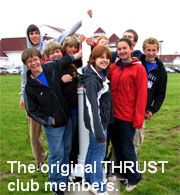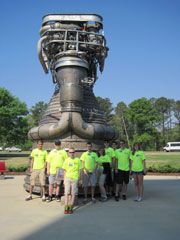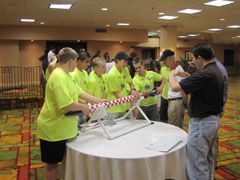Lakeshore Area Rocketry Society
NAR Section #692 and TRA Manitowoc Prefecture #120
NAR Section #692 and TRA Manitowoc Prefecture #120
THRUST - Youth Membership and NAR Section #693
The overall heath of any hobby is dependent upon the interest of new and upcoming members and participants. Lakeshore Area Rocketry Society (LARS) is fortunate and has a "farm club" of sorts in the NAR youth section #693, THRUST (Today's Hobby Rocketry Uniting Sheboygan's Teens). THRUST was started in 2004 to compete in the Rocket for Schools event. THRUST is comprised over a dozen young fliers currently ranging from 6th grade through high school sophomores, of which uniquely are NAR Level 1 JR High Power certified fliers. The club is primarily orientated to promoting science, engineering, mathematics, and interpersonal skills through supporting and participating in the Rocket for Schools event in Sheboygan, WI and the national rocketry program of the NASA Student Launch Initiative.
sophomores, of which uniquely are NAR Level 1 JR High Power certified fliers. The club is primarily orientated to promoting science, engineering, mathematics, and interpersonal skills through supporting and participating in the Rocket for Schools event in Sheboygan, WI and the national rocketry program of the NASA Student Launch Initiative.
THRUST is currently supporting two teams predominately defined by middle school and high school ages. These teams are:
The Fortune 300 (middle school team) come in with a definite "rookie" status for rocket competitions, but do have 4 years of model rocketry and behind the scenes support of the Blue Moon Crew. This group of three young students are entered in the 2011 Rocket for School event with a Class I rocket. The Shuttle Shooters are currently meeting developing their payload and eagerly starting the arduous task of filling in the airframe channels for sanding. Stay tuned for updates from the Shuttle Shooters as the event gets closer.
The Blue Moon Crew (high school team) are the "seasoned" veterans of the club. The team has been together for just over 4 years now and have been top finishers in each event entered. In 2008, The Blue Moon Crew turned a few heads and made unique name for themselves by their payload designs and attention to the airframe construction details. With a Class I rocket name "Cesar Combustus" at the Rocket for Schools event, The Blue Moon Crew developed and presented a payload that created, assembled, and made-ready a Cesar salad. The rocket flee well and the payload was executed. To further acknowledge payload completion, Co-Captain Tyler Jackson ate the salad (....and survived!) This payload was well received (and set a new standard for creativity) and afforded opportunities for the rocket and payload design to be presented to the WI State Assembly and became the talk of the NASA community. When the dust cleared, The Blue Moon Crew finished in Third Place.
 In May 2009, The Blue Moon Crew returned to the Rocket for Schools event in the Class II category with a rocket named "Fishstick" which was creatively painted as rainbow trout supporting the design concept of the payload system. Again working outside the box and being challenged by the team advisers, the team developed a payload that would be separated from the rocket upon decent and would deploy a small sampler mechanism that was calibrated to sample Lake Michigan from the depth of 4 to 10 feet. The sampler would retain the sample until the sampler was purged upon retrieval. Unfortunate high winds and fear for proper flight, Fishstick did not launch. In the end, The Blue Moon Crew again finished surprisingly in Third Place. The year was not over the Blue Moon Crew as starting in 2008, the Rocket for Schools event became a qualifying venue for the NASA Student Launch Initiative (SLI). The top three teams from Rocket for Schools Class II received an invite to participate in the upcoming school year.
In May 2009, The Blue Moon Crew returned to the Rocket for Schools event in the Class II category with a rocket named "Fishstick" which was creatively painted as rainbow trout supporting the design concept of the payload system. Again working outside the box and being challenged by the team advisers, the team developed a payload that would be separated from the rocket upon decent and would deploy a small sampler mechanism that was calibrated to sample Lake Michigan from the depth of 4 to 10 feet. The sampler would retain the sample until the sampler was purged upon retrieval. Unfortunate high winds and fear for proper flight, Fishstick did not launch. In the end, The Blue Moon Crew again finished surprisingly in Third Place. The year was not over the Blue Moon Crew as starting in 2008, the Rocket for Schools event became a qualifying venue for the NASA Student Launch Initiative (SLI). The top three teams from Rocket for Schools Class II received an invite to participate in the upcoming school year.
In October 2009, the phone call and email notice came from NASA and the Blue Moon Crew was one of 14 teams accepted into the 2009-2010 Student Launch Initiative. Of note they were the only team accepted that was a non-TARC (NAR Team America Rocket Competition) and was a full fledged NAR Section. After several quick months of trial and error, weekend and week night design and construction, trial launches and a multiple web conferences with NASA engineers the launch day came in April 2010.
With a custom designed 4-inch diameter rocket about 6 feet in length housing a custom payload designed to produce electricity upon decent. However, much like Apollo 13, the flight was a successful failure. The rocket motor developed a plugged exhaust hole just after launch. The plugged port resulted in the rocket to lose it's altitude until the rocket burned through the plugged exhaust port. With extreme pressure built up by the motor, the pressure was released accelerating the rocket past mach and causing the electronics to prematurely ignite the ejection charges. The rocket fully deployed as designed but experienced some minor airframe damage and some damage tot he payload itself. But with built in natural redundancy, the payload still produced electricity and remote data collected on the flight verifying the results. Six months of work came down to a component that we did not have control of. When the dust settled, and after a very fruitful week on interaction with other teams and formal presentations, the Blue Moon Crew was voted by it's peers the 2010 Team Spirit Award which is the highest award earned at the event. In all a fabulous experience for the team members and mentors.
exhaust hole just after launch. The plugged port resulted in the rocket to lose it's altitude until the rocket burned through the plugged exhaust port. With extreme pressure built up by the motor, the pressure was released accelerating the rocket past mach and causing the electronics to prematurely ignite the ejection charges. The rocket fully deployed as designed but experienced some minor airframe damage and some damage tot he payload itself. But with built in natural redundancy, the payload still produced electricity and remote data collected on the flight verifying the results. Six months of work came down to a component that we did not have control of. When the dust settled, and after a very fruitful week on interaction with other teams and formal presentations, the Blue Moon Crew was voted by it's peers the 2010 Team Spirit Award which is the highest award earned at the event. In all a fabulous experience for the team members and mentors.
 sophomores, of which uniquely are NAR Level 1 JR High Power certified fliers. The club is primarily orientated to promoting science, engineering, mathematics, and interpersonal skills through supporting and participating in the Rocket for Schools event in Sheboygan, WI and the national rocketry program of the NASA Student Launch Initiative.
sophomores, of which uniquely are NAR Level 1 JR High Power certified fliers. The club is primarily orientated to promoting science, engineering, mathematics, and interpersonal skills through supporting and participating in the Rocket for Schools event in Sheboygan, WI and the national rocketry program of the NASA Student Launch Initiative.THRUST is currently supporting two teams predominately defined by middle school and high school ages. These teams are:
The Fortune 300 (middle school team) come in with a definite "rookie" status for rocket competitions, but do have 4 years of model rocketry and behind the scenes support of the Blue Moon Crew. This group of three young students are entered in the 2011 Rocket for School event with a Class I rocket. The Shuttle Shooters are currently meeting developing their payload and eagerly starting the arduous task of filling in the airframe channels for sanding. Stay tuned for updates from the Shuttle Shooters as the event gets closer.
The Blue Moon Crew (high school team) are the "seasoned" veterans of the club. The team has been together for just over 4 years now and have been top finishers in each event entered. In 2008, The Blue Moon Crew turned a few heads and made unique name for themselves by their payload designs and attention to the airframe construction details. With a Class I rocket name "Cesar Combustus" at the Rocket for Schools event, The Blue Moon Crew developed and presented a payload that created, assembled, and made-ready a Cesar salad. The rocket flee well and the payload was executed. To further acknowledge payload completion, Co-Captain Tyler Jackson ate the salad (....and survived!) This payload was well received (and set a new standard for creativity) and afforded opportunities for the rocket and payload design to be presented to the WI State Assembly and became the talk of the NASA community. When the dust cleared, The Blue Moon Crew finished in Third Place.
 In May 2009, The Blue Moon Crew returned to the Rocket for Schools event in the Class II category with a rocket named "Fishstick" which was creatively painted as rainbow trout supporting the design concept of the payload system. Again working outside the box and being challenged by the team advisers, the team developed a payload that would be separated from the rocket upon decent and would deploy a small sampler mechanism that was calibrated to sample Lake Michigan from the depth of 4 to 10 feet. The sampler would retain the sample until the sampler was purged upon retrieval. Unfortunate high winds and fear for proper flight, Fishstick did not launch. In the end, The Blue Moon Crew again finished surprisingly in Third Place. The year was not over the Blue Moon Crew as starting in 2008, the Rocket for Schools event became a qualifying venue for the NASA Student Launch Initiative (SLI). The top three teams from Rocket for Schools Class II received an invite to participate in the upcoming school year.
In May 2009, The Blue Moon Crew returned to the Rocket for Schools event in the Class II category with a rocket named "Fishstick" which was creatively painted as rainbow trout supporting the design concept of the payload system. Again working outside the box and being challenged by the team advisers, the team developed a payload that would be separated from the rocket upon decent and would deploy a small sampler mechanism that was calibrated to sample Lake Michigan from the depth of 4 to 10 feet. The sampler would retain the sample until the sampler was purged upon retrieval. Unfortunate high winds and fear for proper flight, Fishstick did not launch. In the end, The Blue Moon Crew again finished surprisingly in Third Place. The year was not over the Blue Moon Crew as starting in 2008, the Rocket for Schools event became a qualifying venue for the NASA Student Launch Initiative (SLI). The top three teams from Rocket for Schools Class II received an invite to participate in the upcoming school year. In October 2009, the phone call and email notice came from NASA and the Blue Moon Crew was one of 14 teams accepted into the 2009-2010 Student Launch Initiative. Of note they were the only team accepted that was a non-TARC (NAR Team America Rocket Competition) and was a full fledged NAR Section. After several quick months of trial and error, weekend and week night design and construction, trial launches and a multiple web conferences with NASA engineers the launch day came in April 2010.
With a custom designed 4-inch diameter rocket about 6 feet in length housing a custom payload designed to produce electricity upon decent. However, much like Apollo 13, the flight was a successful failure. The rocket motor developed a plugged
 exhaust hole just after launch. The plugged port resulted in the rocket to lose it's altitude until the rocket burned through the plugged exhaust port. With extreme pressure built up by the motor, the pressure was released accelerating the rocket past mach and causing the electronics to prematurely ignite the ejection charges. The rocket fully deployed as designed but experienced some minor airframe damage and some damage tot he payload itself. But with built in natural redundancy, the payload still produced electricity and remote data collected on the flight verifying the results. Six months of work came down to a component that we did not have control of. When the dust settled, and after a very fruitful week on interaction with other teams and formal presentations, the Blue Moon Crew was voted by it's peers the 2010 Team Spirit Award which is the highest award earned at the event. In all a fabulous experience for the team members and mentors.
exhaust hole just after launch. The plugged port resulted in the rocket to lose it's altitude until the rocket burned through the plugged exhaust port. With extreme pressure built up by the motor, the pressure was released accelerating the rocket past mach and causing the electronics to prematurely ignite the ejection charges. The rocket fully deployed as designed but experienced some minor airframe damage and some damage tot he payload itself. But with built in natural redundancy, the payload still produced electricity and remote data collected on the flight verifying the results. Six months of work came down to a component that we did not have control of. When the dust settled, and after a very fruitful week on interaction with other teams and formal presentations, the Blue Moon Crew was voted by it's peers the 2010 Team Spirit Award which is the highest award earned at the event. In all a fabulous experience for the team members and mentors.